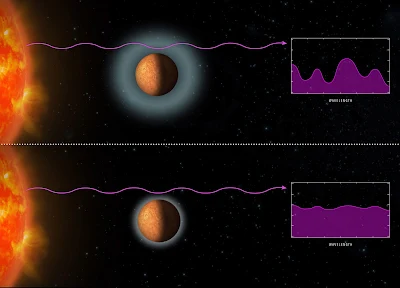Οι
επιστήμονες συνεχίζουν να μελετούν το σύστημα του Trappist-1 για να εντοπίσουν πιο συγκεκριμένα ποιος
ή ποιοι από τους πλανήτες του έχουν τις μεγαλύτερες πιθανότητες να είναι
κατοικήσιμοι. This artist’s impression shows the view just above the
surface of one of the middle planets in the TRAPPIST-1 system, with the glare
of the host star illuminating the rocky surface. At least seven planets orbit
this ultracool dwarf star 40 light-years from Earth and they are all roughly
the same size as the Earth. They are at the right distances from their star for
liquid water to exist on the surfaces of several of them. This artist’s
impression is based on the known physical parameters for the planets and stars
seen, and uses a vast database of objects in the Universe. Credit: ESO/N.
Bartmann
Πρόσθετα
στοιχεία για τους επτά εξωπλανήτες που είχαν ανακαλυφθεί πέρυσι γύρω από το
κοντινό άστρο Trappist-1
σε απόσταση 40 ετών φωτός, έχουν πλέον στα χέρια τους οι επιστήμονες με τη
βοήθεια και του διαστημικού τηλεσκοπίου Hubble. Τα νέα δεδομένα αυξάνουν ακόμη
περισσότερο τις πιθανότητες τουλάχιστον τρεις από τους πλανήτες να διαθέτουν
συνθήκες φιλόξενες για ζωή.
This artist's
concept shows what the TRAPPIST-1 planetary system may look like, based on
available data about the planets' diameters, masses and distances from the host
star, as of February 2018. The new analysis concludes that the seven planets of
TRAPPIST-1 are all rocky, and some could contain significant amounts of water.
TRAPPIST-1 is an ultra-cool dwarf star in the constellation Aquarius, and its
planets orbit very close to it. Image credit: NASA/JPL-Caltech
Με
βάση τα νέα στοιχεία, τα οποία παρουσιάσθηκαν σε τέσσερις μελέτες που
δημοσιεύθηκαν στα περιοδικά αστρονομίας και αστροφυσικής «Nature Astronomy» και «Astronomy and Astrophysics»,
εκτιμάται ότι και οι επτά εξωπλανήτες είναι βραχώδεις, ενώ έως το 5% της μάζας
τους είναι νερό, μια σημαντική ποσότητα σε σχέση με τη Γη, όπου όλοι οι ωκεανοί
αποτελούν μόνο το 0,02% της μάζας της.
Astronomers used
Hubble to analyze light from the nearby star TRAPPIST-1 that passed through the
atmospheres of four Earth-sized planets in the star’s habitable zone. The
graphic at top shows a model spectrum containing the signatures of gases the
astronomers would expect to see if the exoplanets’ atmospheres were puffy and
dominated by primordial hydrogen from the distant worlds’ formation. The Hubble
Space Telescope observations, however, revealed that the planets do not have
hydrogen-dominated atmospheres. The flat spectrum shown in the illustration at
bottom indicates that Hubble did not spot any traces of water or methane, which
are abundant in hydrogen-rich atmospheres. NASA, ESA, and Z. Levy (STScI)
Η
μορφή που βρίσκεται το νερό στους εξωπλανήτες εξαρτάται από το πόση θερμότητα
δέχονται από το άστρο τους, το οποίο έχει μάζα μόλις το 9% του Ήλιου. Πάντως,
και οι επτά πλανήτες φαίνεται να έχουν σχετικά ήπιες επιφανειακές θερμοκρασίες,
συνεπώς -υπό ορισμένες γεωλογικές και ατμοσφαιρικές συνθήκες- είναι πιθανό όλοι
να διαθέτουν νερό σε υγρή μορφή.
These spectra show
the chemical makeup of the atmospheres of four Earth-size planets orbiting
within or near the habitable zone of the nearby star TRAPPIST-1. To obtain the
spectra, astronomers used the Hubble Space Telescope to collect light from
TRAPPIST-1 that passed through the exoplanets’ atmospheres as the alien worlds
crossed the face of the star. The purple curves show the predicted signatures
of gases such as water and methane that absorb certain wavelengths of light.
These gases would be found in a puffy hydrogen-dominated atmosphere similar to
gaseous planets such as Neptune. The Hubble results, noted by the green
crosses, reveal no evidence of an extended atmosphere in three of the
exoplanets (TRAPPIST-1 d, f, and e). Additional observations are needed to rule
out a hydrogen-dominated atmosphere for the fourth planet (TRAPPIST-1 g). NASA,
ESA, and Z. Levy (STScI)
Επιπροσθέτως, οι πέντε τουλάχιστον από τους επτά εξωπλανήτες φαίνεται να στερούνται ατμόσφαιρας από υδρογόνο και ήλιο, όπως συμβαίνει με τον Ποσειδώνα ή τον Ουρανό, κάτι που ενισχύει τις ομοιότητες με το δικό μας ηλιακό σύστημα.
This graph presents
known properties of the seven TRAPPIST-1 exoplanets (labeled b thorugh h),
showing how they stack up to the inner rocky worlds in our own solar system. Credit: NASA/JPL-Caltech
Οι
επιστήμονες συνεχίζουν να μελετούν το σύστημα του Trappist-1 για να εντοπίσουν πιο συγκεκριμένα ποιος
ή ποιοι από τους πλανήτες του έχουν τις μεγαλύτερες πιθανότητες να είναι
κατοικήσιμοι. Μέχρι στιγμής, η εκτίμηση είναι ότι ο τέταρτος σε απόσταση από το
άστρο, ο Trappist-1e, είναι αυτός που μοιάζει περισσότερο με τη
Γη, αν και παραμένει ασαφές προς το παρόν αν διαθέτει ατμόσφαιρα, ποιες
συνθήκες επικρατούν στην επιφάνειά του και αν έχει υγρό νερό.
This chart shows,
on the top row, artist concepts of the seven planets of TRAPPIST-1 with their
orbital periods, distances from their star, radii, masses, densities and
surface gravity as compared to those of Earth. Credit: NASA/JPL-Caltech
Από
τότε που η «επτάδα» ανακαλύφθηκε το Φεβρουάριο του 2017 με τη βοήθεια του τηλεσκοπίου
Trappist στη Χιλή, έχει
εξάψει τη φαντασία επιστημόνων και μη σε όλο τον κόσμο, καθώς, όπως
επιβεβαιώνουν και οι νέες έρευνες, οι επτά εξωπλανήτες μοιάζουν αξιοσημείωτα με
τον Ερμή, την Αφροδίτη, τη Γη και τον Άρη. Τα διαστημικά τηλεσκόπια Hubble, Spitzer και Kepler
της NASA έχουν έκτοτε
μελετήσει το πλανητικό σύστημα του Trappist, ενώ το ίδιο θα κάνει και το μελλοντικό ισχυρότερο διαστημικό
τηλεσκόπιο James
Webb.
This illustration
shows the seven Earth-size planets of TRAPPIST-1. The image does not show the
planets' orbits to scale, but highlights possibilities for how the surfaces of
these intriguing worlds might look. Image
Credit: NASA/JPL-Caltech
Οι
πλανήτες του άστρου Trappist-1
βρίσκονται τόσο κοντά μεταξύ τους, που ένας παρατηρητής, ο οποίος θα βρισκόταν
στην επιφάνεια ενός από αυτούς, θα είχε θεαματική θέα των γειτονικών πλανητών
στον ουρανό, μερικοί από τους οποίους θα φαίνονταν μεγαλύτεροι και από τη
Σελήνη. Παρ' όλο που και οι επτά βρίσκονται κοντύτερα στο άστρο τους από ό,τι ο
Ερμής στον Ήλιο, δεν «ψήνονται», επειδή ο Trappist-1 είναι ένα πολύ αχνό άστρο.
Προς
το παρόν, σύμφωνα με τους επιστήμονες είναι αδύνατο να γνωρίζουμε πώς ακριβώς
είναι ο κάθε πλανήτης. Με βάση τα έως τώρα δεδομένα, οι καλύτερες εκτιμήσεις
είναι ότι:
Astronomers using
the Hubble Space Telescope have conducted the first spectroscopic survey of
Earth-sized planets in the TRAPPIST-1 system's habitable zone. Hubble reveals
that at least the inner five planets do not seem to contain puffy,
hydrogen-rich atmospheres similar to gaseous planets such as Neptune. This
means the atmospheres may be more shallow and rich in heavier gases like carbon
dioxide, methane, and oxygen. Credit: NASA’s Goddard Space Flight
Center/Katrina Jackson
- Ο Trappist-1b, ο πιο εσωτερικός πλανήτης, έχει πιθανότατα ένα βραχώδη πυρήνα και περιβάλλεται από μια ατμόσφαιρα πιο πυκνή από τη γήινη.
- Ο Trappist-1c είναι βραχώδης αλλά με πιο αραιή ατμόσφαιρα.
- Ο Trappist-1d είναι ο πιο ελαφρύς από όλους, έχοντας μόνο το 30% της μάζας της Γης. Είναι αβέβαιο αν έχει μεγάλη ατμόσφαιρα, ωκεανό ή στρώμα πάγου.
- Ο Trappist-1e είναι ο μόνος από τους επτά που είναι ελαφρώς πυκνότερος από τη Γη, πράγμα που ίσως οφείλεται στο ότι διαθέτει πιο πυκνό πυρήνα σιδήρου από ό,τι ο πλανήτης μας. Όπως ο 1c, φαίνεται να έχει σχετικά αραιή ατμόσφαιρα. Από άποψη μεγέθους, πυκνότητας και ακτινοβολίας που δέχεται από το άστρο του, εμφανίζει την μεγαλύτερη ομοιότητα με τη Γη.
- Οι άλλοι τρεις πλανήτες Trappist-1f, g και h απέχουν περισσότερο από το άστρο τους και το νερό σε αυτούς μπορεί να βρίσκεται σε μορφή πάγου. Αν έχουν αραιές ατμόσφαιρες, είναι απίθανο να περιέχουν γήινα βαριά μόρια όπως το διοξείδιο του άνθρακα.
Πηγές: Julien
de Wit et al, Atmospheric reconnaissance of the habitable-zone Earth-sized
planets orbiting TRAPPIST-1, Nature Astronomy (2018). DOI: 10.1038/s41550-017-0374-z -
https://exoplanets.nasa.gov/news/1483/hubble-probes-atmospheres-of-exoplanets-in-trappist-1-habitable-zone/ - //hubblesite.org/news_release/ne... - http://www.tovima.gr/science/article/?aid=940230









